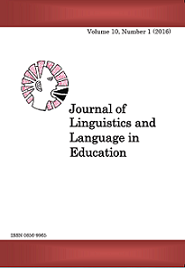Possessive Noun Phrase: From Simple to Complex
Abstract
This study seeks to examine the possible expandability of possessive noun phrase (PNP) in Kisubi, a Bantu language spoken natively in Biharamulo district located in the north-western part of Kagera region, Tanzania. Precisely, the core objective of this paper is to investigate the presence of potential syntactic slots between the head noun (N1 €“ herein referred to as the possessee) and the dependent noun (N2 €“ herein referred to as the possessor), and the way they are patterned in relation to the head noun. Similarly, the paper investigates the saturational level of the PNP. Furthermore, the study confines itself to the nominal possessive noun phrases because of their potentiality of having syntactic slots between N1 and N2; and it is guided by the Phrase Structure Grammar (PSG). The data are generated by six (6) native speakers of Kisubi, who are obtained through snowball sampling technique. They are collected using structured interview, introspection and Focus Group Discussion; and are analysed using tables and tree structure inherent in PSG. The findings established that there is a maximum of five (5) syntactic slots between N1 and N2, and they are occupied by elements such as demonstrative, adjective, quantifier, numeral and ordinal. Of the elements (herein referred to as syntactic intrusives), the demonstrative is designated as a determiner because of its syntactic behaviour of occurring consistently closer to the head noun; and the remaining elements are designated as modifiers because of their syntactic behaviour of hopping from one syntactic position to another.
Key words: possessive noun phrase, syntactic intrusive, determiner, modifier, peripheral modifiers, alienable, inalienable, phrase structure grammar, possessor, possessee, etc.
References
Alexiadou, A., Haegeman, L. & Stavrou, M. (2007). Noun Phrase in
the Generative Perspective. Berlin: Walter de Gyuyter GmbH
& Co.
Brinton, L. J. (2000). The Structure of Modern English: A Linguistic
Introduction. The Netherlands: John Benjamins Publishing
Company.
Den Dikken, M. (2006). Relators and Linkers. MIT Press.
Dobler, E. (2008). The Morpho-phonology of (in)alienable Possession.
The Proceedings of the 2008 Annual Conference of the
Canadian Linguistic Association.
Ethnologue. (2013). Languages of the World. Berlin: Walter de
Gyuyter GmbH & Co.
Gebregziabher, K. (2012). The Alienable-inalienable Asymmetry:
Evidence from Tigrinya. In R. M. Michael et al. (eds.). Selected
Proceedings of the 42ndAnnual Conference on African
Linguistics. Somerville, MA: Cascadilla Proceedings Project:
€“182.
Guma, S. M. (1971). An Outline Structure of Southern Sotho.
Pietermaritzburg: Shuter and Shooter.
Guthrie, M. (1967-71). Comparative Bantu: An Introduction to
Comparative Linguistics and the Prehistory of the Bantu
Languages (4 vols). Farnborough: Gregg Press.
Harford, C. (1985). Aspects of Complementation in Three Bantu
Languages. PhD Dissertation, Indiana University,
Bloomington.
Hyman, L. (1977). The Syntax of Body Parts. In Byarushengo et al. (eds.). Haya Grammatical Structure. Los Angeles,
Department of linguistics, University of Southern California.
Kula, N. C. (2009). Nominal Compounding and Associative Phrases
in Bemba. In M. Brenzinger & A. M. Fehn (eds.). Selected Proceedings of the 6th World Congress of African Linguistics,
Cologne: KÓ§ppe: 431 €“441.
Lukusa, S. T. M. (2002). Groundwork in Shiyeyi Grammar with
Shiyeyi-English Glossary. Frankfurt am Mainz: Peter Lang.
Lusekelo, A. (2009b). The Structure of the Swahili Noun Phrase:
Evidence from Fictional Narratives. In W. Burger & M. Pienaar (eds.). Die Tand van die Tyd: Opstelle Opgedra aan Jac Conradie, Bloemfontein: Sun Press: 45 €“60.
Maho, J. F. (2009). The Online Version of the New Updated Guthrie
List: A Referential Classification of the Bantu Languages.
Matambirofa, F. (2000), Some Aspects of the Architecture of the
Possessive Noun Phrase in Bantu. Zambezia, XXVII(I), University of Zimbabwe.
Matlhaku, K. & Rose, L. (2014). The Syntax of the Setswana Noun
Phrase. Marang: Journal of Language and Literature, 24.
Mohammed, M. A. (2001). Modern Swahili Grammar. Nairobi: East
African Educational Publishers.
Moller, M. (2011). The Noun Phrase in Kwere, a Bantu Language of
Tanzania, Goteborgs Universitet.
Mugane, J. (1995). Gĩkũyũ NP Morpho-syntax. In I. Maddieson & T. J. Hinnebusch (eds.) Trends in African Linguistics 2: Language History and Linguistic Description in Africa. Trenton New Jersey: Africa World Press, Inc.
Mugane, J. M. (1997). A Paradigmatic Grammar of Gikuyu,
Stanford, CSLI Publications.
Ndomba, R. (2006). Samatengo Noun Phrase Structure. Unpublished MA (Linguistics) Dissertation, University of Dar es Salaam.
Polomé, E. C. (1967). Swahili Language Handbook. Washington DC: Centre for Applied Linguistics.
Rosenbach, A. (2002), Genitive Variation in English: Conceptual
Factors in Synchronic and Diachronic Studies. Berlin & New York: Mouton de Gruyter.
Rugemalira, J. M. (1993). Runyambo Verb Extensions and
Constraints on Predicate Structure. Published PhD Thesis,
University of California at Berkeley, USA: University of
California.
Rugemalira, J. M. (2007). The Structure of Bantu Noun Phrase.
SOAS Working Papers in Linguistics, 15: 135 €“148.
Rugemalira, J. M. & Muzale, H. R. T. (2008). Researching and
Documenting the Languages of Tanzania. Language Documentation and Conservation, 2(1), Tanzania: LOT
Project: 68 €“108.
Taljaard, P. C. & Bosch, S. E. (1988). A Handbook of IsiZulu.
Pretoria: J. L. Van Schaik (Pvt).
Van de Velde, M. (2005). The Order of Noun and Demonstrative in
Bantu. In K. Bostoen & J. Maniacky (eds.). Studies in African
Comparative Linguistics with Special Focus on Bantu and Mande. Tervuren: Royal Museum for Central Africa: 425 €“44.
Downloads
Published
Issue
Section
License
Copyright © by Department of Foreign Languages and Linguistics, University of Dar es Salaam
All rights reserved. No part of this publication may be reproduced or transmitted in any form or by any means, electronic or mechanical, including photocopying, recording, or any information storage or retrieval system, without permission in writing from the publisher, except for short extracts in fair dealing, for research or private study, critical scholarly review or discourse with an acknowledgement.



